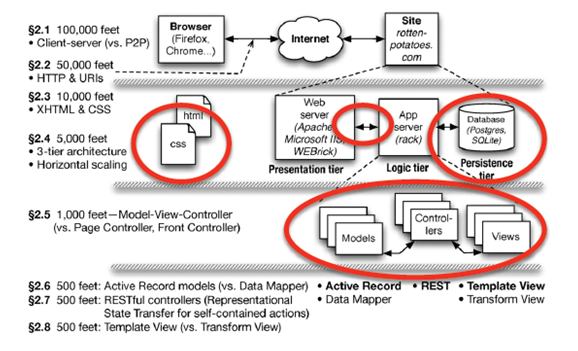CSC/ECE 517 Fall 2012/ch2b 1w61 ns
Connecting Architectural Concepts to Rails Applications
The structure of a typical Rake file is as follows:
app /models/, views/, controllers/
/helpers
/assets/stylesheets/application.css
config /routes.rb
/database.yml
db /development.sqlite3,test.sqlite3
/migrate/
log /development.log, test.log
There is no special format for a Rakefile. A Rakefile contains executable Ruby code. Anything legal in a ruby script is allowed in a Rakefile. It is tailored to specifying tasks and actions, the idioms used in a Rakefile are designed to support that.
Tasks
Tasks are the main unit of work in a Rakefile. Tasks usually have a name, a list of prerequisites and a list of actions.
task :name //the task method takes a single parameter which is the name of the task
Any prerequisites are given as a list which are inclosed in square brackets followed by the name and an arrow (=>).
task :name => [:prereq1, :prereq2]
Actions can be defined by passing a block to the task method. Any Ruby code can be placed in the block. The block may reference the task object via the block parameter.
task :name => [:prereq1, :prereq2] do |t| # actions (may reference t) end
A Typical Rails Application
Rails is a web application development framework written in the Ruby language. It has been designed to make programming web applications easier and allows the programmer to write less code when compared to other languages and frameworks.
An exemplary Rails application has the following structure.

The upper most layer consists of the web application that is seen running on the browser and this is the part of the application that the user is made to see.
The middle layer consists of the 3 tier architecture which provides horizontal scaling. The CSS style sheets are used to style the html view of the application. As seen in the diagram, the Presentation tier consists of the Web Server, the Logic tier is represented by the App Server and the Persistence Tier by the Database. The routes play a crucial role in communication between the Presentation tier and the Logic tier. The persistence tier consists of three different types of databases that are used during the course of development and testing of the application. All the activities carried out in setting up and testing the application are logged for future reference and easier debugging.
The lowermost layer consists of the MVC (Model View Controller) which is the core aspect of the Ruby On Rails application. Each entity has a model, controller and a set of views. This layer provides isolation of business logic from the user interface and also facilitates in keeping the code DRY (Don’t Repeat Yourself).
Rails as an MVC Framework
The core of the Rails application is the MVC i.e the Model-View-Controller. As mentioned earlier, the MVC helps to keeps your business logic separated from the HTML views and also keeps your code clean and neat helping in easier maintenance.
- Model
Model represents the information or data of the application and the rules to manipulate that data. It is the Model that is linked to the Persistence Tier and is primarily used for managing the rules of interaction with a corresponding relational database table. Typically, each table in the database will correspond to one model in the application. A major bulk of the application’s business logic is concentrated in the models.
Models are sub classes of ActiveRecord::Base which is an Object Relational Mapping layer (ORM)that is useful in connecting to the database.
- View
View represents the user interface of the application. They are often HTML files with embedded Ruby code that perform tasks related solely to the presentation of the data. It is the View that is responsible for providing data to the web browser or any other source that accesses the application.
Views are sub classes of ActionView which provides reusable code that is used to manipulate views.
- Controller
Controller is the component that glues the models and views. The controller is responsible for processing the incoming requests from the web browser, effectively use the routing system, interrogating the models for data, and passing that data and causing the rendering of the correct view for presentation.
Controllers are sub classes of ApplicationController which provide common functionality which can be used accordingly in the user application.
Rails Philosophies
The Rails philosophy includes several guiding principles: • DRY – “Don’t Repeat Yourself” – suggests that writing the same code over and over again is a bad thing. • Convention Over Configuration – means that Rails makes assumptions about what you want to do and how you’re going to do it, rather than requiring you to specify every little thing through endless configuration files. • REST is the best pattern for web applications – organizing your application around resources and standard HTTP verbs is the fastest way to go.